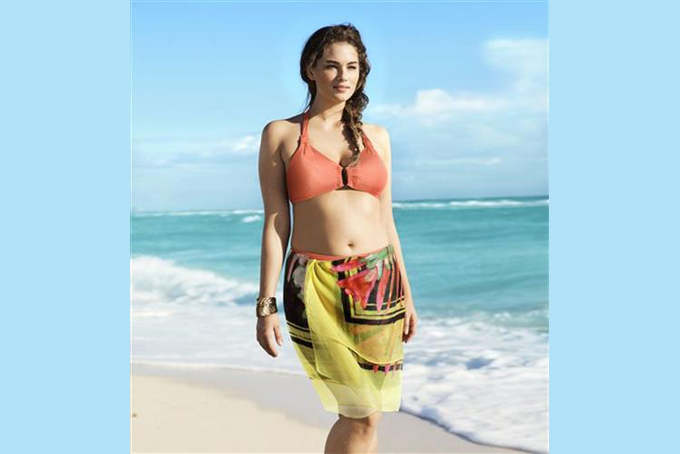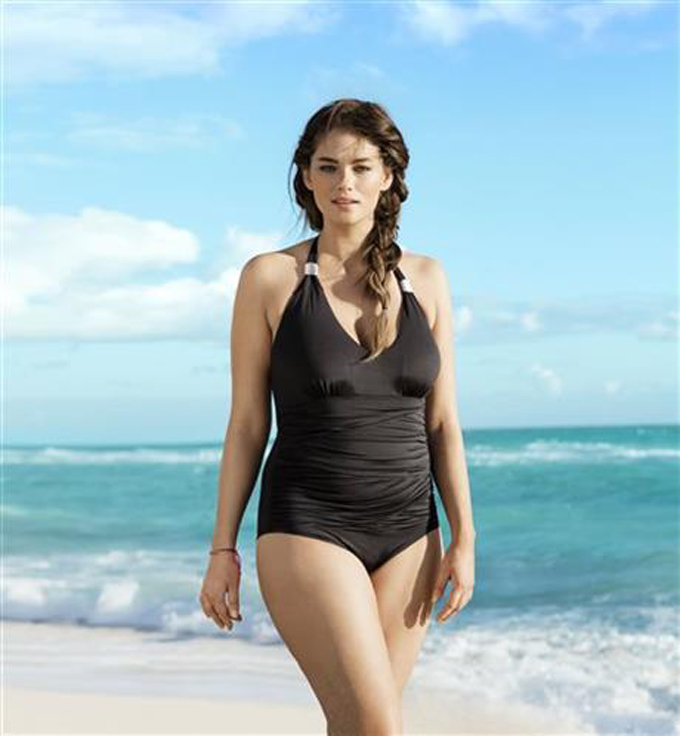
This undated image provided by H&M shows plus-size model Jennie Runk, who is a size 12 or 14, in a swimsuit ad from 2012. (AP Photo/H&M)
by Mae Anderson
AP Retail Writer
NEW YORK (AP) — When it comes to women’s clothing sizes, there’s some funny math going on.
The average American woman is about 25 pounds heavier than she was in 1960. Yet women’s plus-size clothing, generally defined as size 14 and up, still makes up only about 9 percent of the $190 billion spent annually on clothes.
What’s wrong with this equation? It’s not that plus-size women aren’t into fashion. Rather, the fashion industry doesn’t seem interested in them.

This undated image provided by H&M shows plus-size model Jennie Runk, who is a size 12 or 14, in a swimsuit ad from 2012. (AP Photo/H&M)
The fashion industry has long spent more time, money and marketing on clothing for taut bodies than for curvier ones because it’s easier and more profitable to do so. But retail analysts and plus-size women say there’s something else at play: Stereotypes about larger women not wanting to dress fashionably keep companies from making clothes that are flattering to them. And in turn, that discourages them from spending more.
“There is still an interesting stigma attached to plus-size fashion and the woman who wears it,” says Marie Denee, who wears a size 16 and studies the industry via her website TheCurvyFashionista.com. “Many think ‘Oh, she doesn’t want to draw attention, live life, date, be confident, wear fitted clothes with bold colors and patterns,’ when the exact opposite is true.”
Carmen Barrington, 32, says that attitude has resulted in fewer plus-size options. Barrington, who wears around a size 22, lamented recently after a day of shopping at Forever 21, Lane Bryant and other stores that she sometimes can’t even find decent plus-size clothing at retailers that specialize in it.
“It was a hot, annoying day, and I spent it trying on stuff, and came up with nothing,” Barrington, who works in human resources, says. “There’s this aversion to being associated with plus-size clothes.”
To be sure, sizing is an inexact science. Women’s sizes were developed in the 1920s as catalogues became popular and ready-to-wear clothing replaced tailor made or self-sewn items.
But while a system of men’s standard sizing based on chest sizes in the Army had worked well, a similar attempt to base women’s sizes on bust measurements wasn’t as reliable. Women’s bust sizes are more variable.
In the 1930s, retailers began adopting even-numbered sizes commonly ranging from 14 to 24, says Alaina Zulli, a dressmaker who studies costume history. But those sizes bore little resemblance to those used today — a size 24 back then, for instance, would be a size 14 today — so the issues of not having enough plus-size fashions likely was not as pronounced.
The sizes stayed the same but the numbers decreased gradually, Zulli says, about 1 size a decade. This is known as “vanity sizing” because it gives women the impression that they’re fitting into a smaller size.
Women’s sizes, which today range from 0 to 24 but vary from store to store, haven’t evolved much for decades. And for the most part, neither have the range of plus-size fashions.